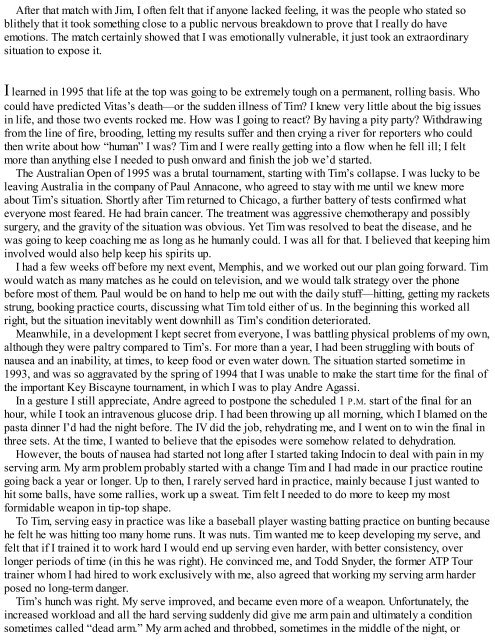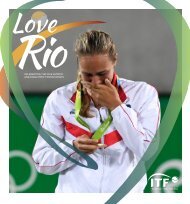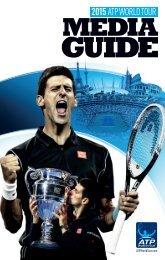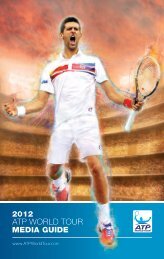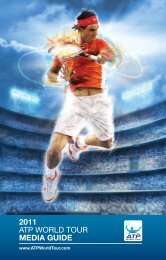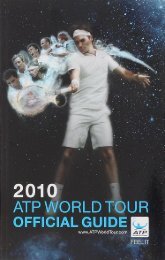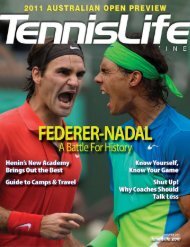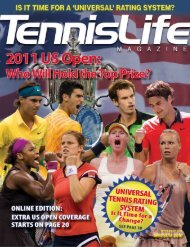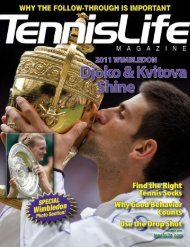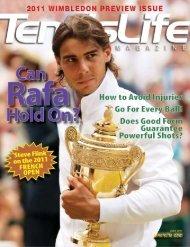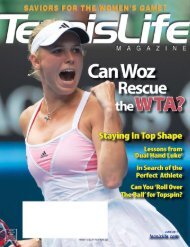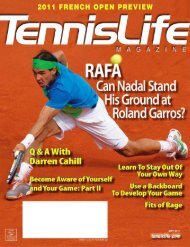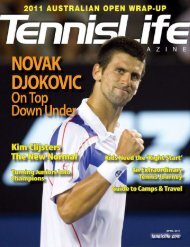A Champion's Mind - Pete Sampras
www.tennismoscow.me Insta:TENNISMOSCOW
www.tennismoscow.me Insta:TENNISMOSCOW
You also want an ePaper? Increase the reach of your titles
YUMPU automatically turns print PDFs into web optimized ePapers that Google loves.
After that match with Jim, I often felt that if anyone lacked feeling, it was the people who stated so<br />
blithely that it took something close to a public nervous breakdown to prove that I really do have<br />
emotions. The match certainly showed that I was emotionally vulnerable, it just took an extraordinary<br />
situation to expose it.<br />
I learned in 1995 that life at the top was going to be extremely tough on a permanent, rolling basis. Who<br />
could have predicted Vitas’s death—or the sudden illness of Tim? I knew very little about the big issues<br />
in life, and those two events rocked me. How was I going to react? By having a pity party? Withdrawing<br />
from the line of fire, brooding, letting my results suffer and then crying a river for reporters who could<br />
then write about how “human” I was? Tim and I were really getting into a flow when he fell ill; I felt<br />
more than anything else I needed to push onward and finish the job we’d started.<br />
The Australian Open of 1995 was a brutal tournament, starting with Tim’s collapse. I was lucky to be<br />
leaving Australia in the company of Paul Annacone, who agreed to stay with me until we knew more<br />
about Tim’s situation. Shortly after Tim returned to Chicago, a further battery of tests confirmed what<br />
everyone most feared. He had brain cancer. The treatment was aggressive chemotherapy and possibly<br />
surgery, and the gravity of the situation was obvious. Yet Tim was resolved to beat the disease, and he<br />
was going to keep coaching me as long as he humanly could. I was all for that. I believed that keeping him<br />
involved would also help keep his spirits up.<br />
I had a few weeks off before my next event, Memphis, and we worked out our plan going forward. Tim<br />
would watch as many matches as he could on television, and we would talk strategy over the phone<br />
before most of them. Paul would be on hand to help me out with the daily stuff—hitting, getting my rackets<br />
strung, booking practice courts, discussing what Tim told either of us. In the beginning this worked all<br />
right, but the situation inevitably went downhill as Tim’s condition deteriorated.<br />
Meanwhile, in a development I kept secret from everyone, I was battling physical problems of my own,<br />
although they were paltry compared to Tim’s. For more than a year, I had been struggling with bouts of<br />
nausea and an inability, at times, to keep food or even water down. The situation started sometime in<br />
1993, and was so aggravated by the spring of 1994 that I was unable to make the start time for the final of<br />
the important Key Biscayne tournament, in which I was to play Andre Agassi.<br />
In a gesture I still appreciate, Andre agreed to postpone the scheduled 1 P.M. start of the final for an<br />
hour, while I took an intravenous glucose drip. I had been throwing up all morning, which I blamed on the<br />
pasta dinner I’d had the night before. The IV did the job, rehydrating me, and I went on to win the final in<br />
three sets. At the time, I wanted to believe that the episodes were somehow related to dehydration.<br />
However, the bouts of nausea had started not long after I started taking Indocin to deal with pain in my<br />
serving arm. My arm problem probably started with a change Tim and I had made in our practice routine<br />
going back a year or longer. Up to then, I rarely served hard in practice, mainly because I just wanted to<br />
hit some balls, have some rallies, work up a sweat. Tim felt I needed to do more to keep my most<br />
formidable weapon in tip-top shape.<br />
To Tim, serving easy in practice was like a baseball player wasting batting practice on bunting because<br />
he felt he was hitting too many home runs. It was nuts. Tim wanted me to keep developing my serve, and<br />
felt that if I trained it to work hard I would end up serving even harder, with better consistency, over<br />
longer periods of time (in this he was right). He convinced me, and Todd Snyder, the former ATP Tour<br />
trainer whom I had hired to work exclusively with me, also agreed that working my serving arm harder<br />
posed no long-term danger.<br />
Tim’s hunch was right. My serve improved, and became even more of a weapon. Unfortunately, the<br />
increased workload and all the hard serving suddenly did give me arm pain and ultimately a condition<br />
sometimes called “dead arm.” My arm ached and throbbed, sometimes in the middle of the night, or


